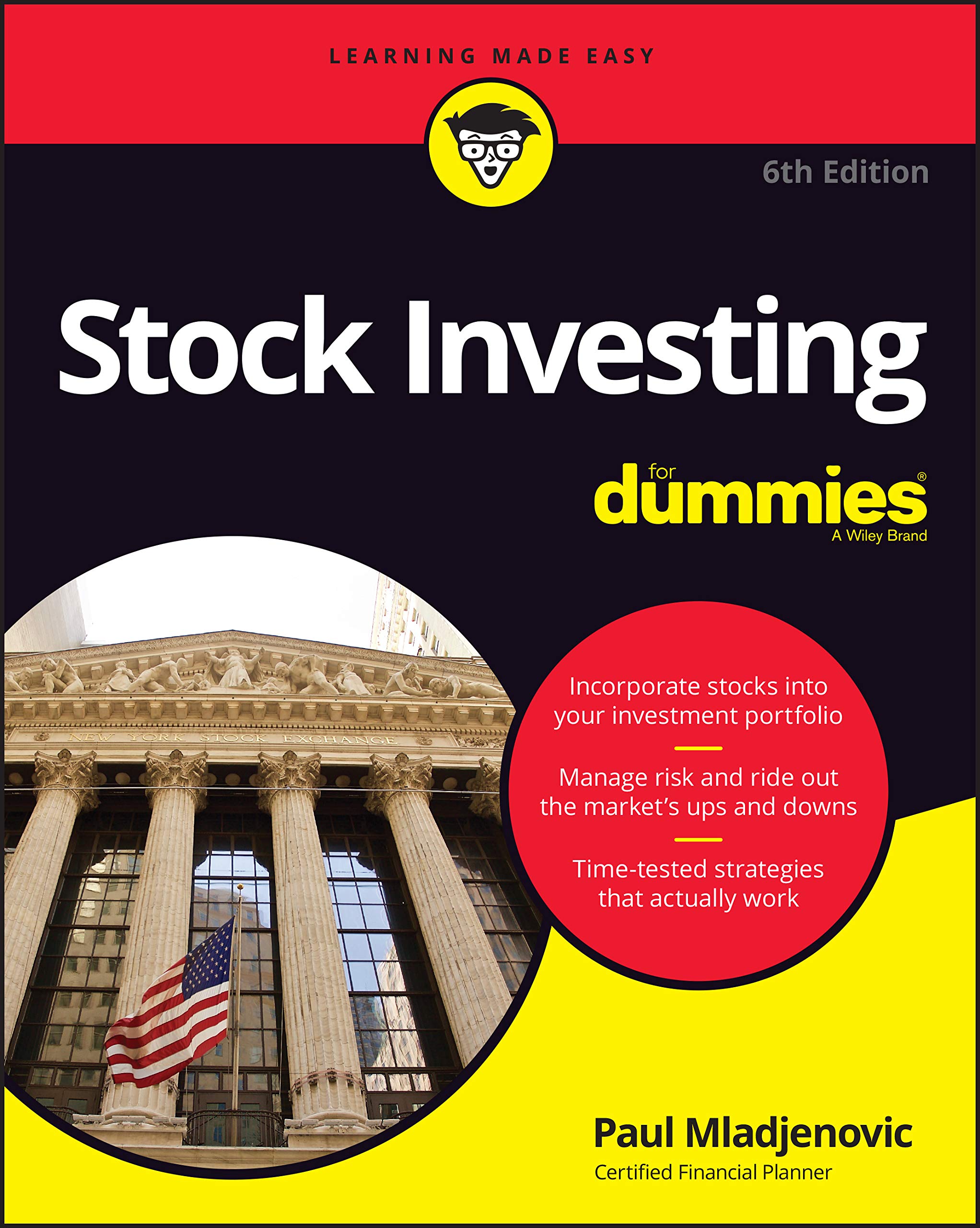Stock Investing for Dummies
The bestselling guide to holding steady through the stock market’s highs, lows, and stable stretches
When you decide to jump into the stock market, there’s a lot to know. Stock Investing For Dummies covers the factual and emotional aspects of putting your money into stocks. In clear, easy-to-understand language, this book explains the numbers behind the stocks, the different categories of stocks, and strategies for building a solid portfolio. On the flip side, it also addresses the emotional aspects of investing: setting goals, knowing when to sell, and balancing risk vs. return.
For nearly a century, the well-to-do have been building their wealth by investing in stocks. Here’s your opportunity to do the same. The sooner you start investing, the sooner you’ll see your money grow. Make that a reality by discovering:
Approaches for investing for income or growthSteps for evaluating your financial health, setting financial goals, and funding your first purchasesHow to read stock tables and pull information out of stock chartsWhat to look for on balance sheets, income statements, and annual reports to choose strong performersAdvice for minimizing losses and maximizing gainsTax implications and how to reduce their impact on your earningsSuggestions on what to do and buy in a down market
Put all of this information together, and you have a straightforward resource that helps you build and manage a portfolio that will serve you well for years to come. Stock Investing For Dummies gives you the confidence you need to send your portfolio soaring!
From the Publisher


Should I invest in stocks or trade them?
Stocks of profitable, well-run companies are great long-term investments. Think 5 years or longer as an investment timeline. Given that, it is not difficult to be successful over time with a smart investment strategy. On the other hand, trading stocks is a more short-term and speculative approach to the market. While you can make big gains quickly, it’s also high risk and much easier to lose money…and fast!
What is the difference between fundamental analysis and technical analysis and when do I use each?
When you are investing, especially for the long term, you should do fundamental analysis. Fundamental analysis is how you look at the underlying company…its profits, sales, market share, etc. Technical analysis is about understanding the right time to invest in (or sell) a stock by examining market trends, volume, costs, etc. to determine the right entry or exit point. The “fundamentals” helps you decide what to buy while the “technicals” tell you when to buy.
How does investing in a stock compare to speculating?
Investing means you are looking at the underlying company and making sure it “has the right stuff” to be in your long-term portfolio. Speculating is much riskier and requires investors to make a guess about how the company’s stock might perform in the near term.
What are the three most important things to consider before investing in a stock?
Profit is the most important thing to look at when you are thinking about investing in a public company’s stock. Ideally, the stock should be a consistent performer with at least three or more years of profitability. You should also make sure the company has rising sales. Finally, make sure the company is selling products or services that will have customer demand and a market for buying in the foreseeable future.
Should I look for stocks with gains or dividends?
That depends on what type of investor you are. If you’re looking for stocks with appreciation potential, or capital gains, check out well-positioned companies in growing industries. If you’re looking at stock investing for income potential, e.g. an investor heading into retirement, then your main focus should be on companies that consistently pay dividends.
What sectors should beginning stock investors consider?
Companies that sell products or services that meet human needs are good places for beginning investors to start. Look for consumer staples like food or beverages, utilities, or need-to-have goods and services.
About the Book:
Investing in gold and silver is a great way to diversify your portfolio. Gold and silver perform well and can turn a profit during periods of inflation and economic uncertainty. Both metals outperformed stocks in recent years and continue to do well. So, you’ve become stock savvy. Ready to turbo-charge your portfolio like a pro? Get advanced investing and speculation advice plus the inside scoop on call and put options and ETFs, both conventional and leveraged and inverse funds. Imagine having companies pay you for referring customers to their products. Affiliate Marketing is a perfect part-time gig for anyone with a laptop and the desire to generate profits with one of the easiest e-commerce business models around. Go beyond building wealth with stocks and start earning cash with a home-based business of your dreams. Find the right business to fit your interests and schedule and turn a passion into a profit by sharing your products and services with the world.
Publisher : For Dummies; 6th edition (May 19, 2020)
Language : English
Paperback : 400 pages
ISBN-10 : 1119660769
ISBN-13 : 978-1119660767
Item Weight : 1.2 pounds
Dimensions : 7.2 x 1 x 9 inches
$12.60
Price: $12.60
(as of Aug 25, 2023 09:07:22 UTC – Details)
The bestselling guide to holding steady through the stock market’s highs, lows, and stable stretches
When you decide to jump into the stock market, there’s a lot to know. Stock Investing For Dummies covers the factual and emotional aspects of putting your money into stocks. In clear, easy-to-understand language, this book explains the numbers behind the stocks, the different categories of stocks, and strategies for building a solid portfolio. On the flip side, it also addresses the emotional aspects of investing: setting goals, knowing when to sell, and balancing risk vs. return.
For nearly a century, the well-to-do have been building their wealth by investing in stocks. Here’s your opportunity to do the same. The sooner you start investing, the sooner you’ll see your money grow. Make that a reality by discovering:
Approaches for investing for income or growthSteps for evaluating your financial health, setting financial goals, and funding your first purchasesHow to read stock tables and pull information out of stock chartsWhat to look for on balance sheets, income statements, and annual reports to choose strong performersAdvice for minimizing losses and maximizing gainsTax implications and how to reduce their impact on your earningsSuggestions on what to do and buy in a down market
Put all of this information together, and you have a straightforward resource that helps you build and manage a portfolio that will serve you well for years to come. Stock Investing For Dummies gives you the confidence you need to send your portfolio soaring!
From the Publisher


Should I invest in stocks or trade them?
Stocks of profitable, well-run companies are great long-term investments. Think 5 years or longer as an investment timeline. Given that, it is not difficult to be successful over time with a smart investment strategy. On the other hand, trading stocks is a more short-term and speculative approach to the market. While you can make big gains quickly, it’s also high risk and much easier to lose money…and fast!
What is the difference between fundamental analysis and technical analysis and when do I use each?
When you are investing, especially for the long term, you should do fundamental analysis. Fundamental analysis is how you look at the underlying company…its profits, sales, market share, etc. Technical analysis is about understanding the right time to invest in (or sell) a stock by examining market trends, volume, costs, etc. to determine the right entry or exit point. The “fundamentals” helps you decide what to buy while the “technicals” tell you when to buy.
How does investing in a stock compare to speculating?
Investing means you are looking at the underlying company and making sure it “has the right stuff” to be in your long-term portfolio. Speculating is much riskier and requires investors to make a guess about how the company’s stock might perform in the near term.
What are the three most important things to consider before investing in a stock?
Profit is the most important thing to look at when you are thinking about investing in a public company’s stock. Ideally, the stock should be a consistent performer with at least three or more years of profitability. You should also make sure the company has rising sales. Finally, make sure the company is selling products or services that will have customer demand and a market for buying in the foreseeable future.
Should I look for stocks with gains or dividends?
That depends on what type of investor you are. If you’re looking for stocks with appreciation potential, or capital gains, check out well-positioned companies in growing industries. If you’re looking at stock investing for income potential, e.g. an investor heading into retirement, then your main focus should be on companies that consistently pay dividends.
What sectors should beginning stock investors consider?
Companies that sell products or services that meet human needs are good places for beginning investors to start. Look for consumer staples like food or beverages, utilities, or need-to-have goods and services.
About the Book:
Investing in gold and silver is a great way to diversify your portfolio. Gold and silver perform well and can turn a profit during periods of inflation and economic uncertainty. Both metals outperformed stocks in recent years and continue to do well. So, you’ve become stock savvy. Ready to turbo-charge your portfolio like a pro? Get advanced investing and speculation advice plus the inside scoop on call and put options and ETFs, both conventional and leveraged and inverse funds. Imagine having companies pay you for referring customers to their products. Affiliate Marketing is a perfect part-time gig for anyone with a laptop and the desire to generate profits with one of the easiest e-commerce business models around. Go beyond building wealth with stocks and start earning cash with a home-based business of your dreams. Find the right business to fit your interests and schedule and turn a passion into a profit by sharing your products and services with the world.
Publisher : For Dummies; 6th edition (May 19, 2020)
Language : English
Paperback : 400 pages
ISBN-10 : 1119660769
ISBN-13 : 978-1119660767
Item Weight : 1.2 pounds
Dimensions : 7.2 x 1 x 9 inches






